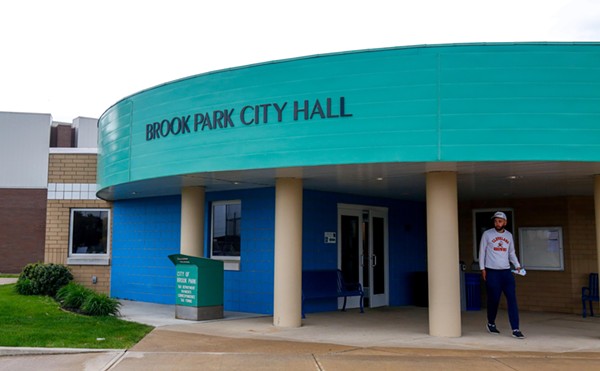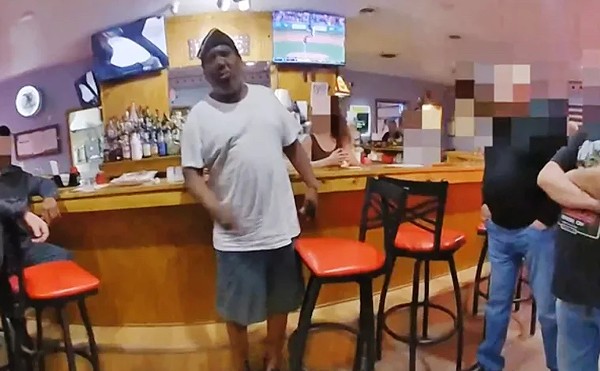After spending part of that day in August 2004 filling out job applications, Tom and longtime friend Jim Walsh returned to the Hudson home that 23-year-old Tom shared with his mother and sister. They were watching a movie in the living room when Tom's older sister Katie came home from work. She said hello, then left again to take the dog for a walk.
Tom got up and headed for the garage to smoke a cigarette. On his way back, he passed the couch where Jim sat, finally plopping down onto the floor near the basement steps. Jim glanced over, then went back to watching the movie; Tom's few remaining friends had become accustomed to strange behavior. When Katie returned a few minutes later and screamed, Jim looked again. Tom was lying on the floor in the fetal position, in a pool of blood. A red-smeared kitchen knife lay nearby.
In the ambulance on the way to the hospital, a paramedic revived Tom briefly. Asked why he'd stabbed himself repeatedly in his abdomen (doctors would later find nine wounds), Tom said, "I couldn't make the voices go away."
Those closest to Tom knew about the voices. No one was sure how long he'd been hearing them, but his weakening hold on reality became obvious in the months before his suicide. Attempts to get his life together had become more sporadic and short-lived. He was convinced that he was being followed and spied on -- to the point that he called the police on several occasions. He told friends he was telepathic, and he may have contemplated killing a local girl whose voice he couldn't get out of his head.
Unlike many who suffer from mental illness, Tom Sauer did not lack professional care. Indeed, he had access to all manner of prescription medication -- and his family wonders whether that might have been his greatest problem. Apparently, Tom was addicted to one medication for years. His family was aware of his reliance on the drug, and his friends saw how he misused it. But the professionals who provided it to him were in the best position to know the extent of his abuse, and it's not clear how careful they were -- even as they prescribed ever more pills.
Situated halfway between Cleveland and Akron, Hudson is a dense web of subdivisions, ranging from older homes in wooded neighborhoods like Greencrest and Leeway Acres to the small mansions of Chadd's Ford and Canterbury-on-the-Lakes. In the spring, ChemLawn trucks prowl the streets; weeds are practically illegal.
Enterprising high school kids do landscaping work in their spare time. One pulls his tractors behind a Cadillac Escalade. In Hudson, keeping up appearances isn't just an adult obsession.
When Tom was five years old, the Sauers moved to Hudson from Bloomfield Hills, Michigan. They lived in a colonial house in a quiet neighborhood on the north side of town. Thomas Sauer worked as vice president of Huntington Trust Company in Cleveland, while Joan, a teacher, stayed home to take care of Tom and his two older sisters, Jane and Katie.
Slowly, the family fell apart. Shortly before Tom was born, Thomas was diagnosed with bipolar disorder, also known as manic depression. Joan says that her husband became controlling and paranoid, and often slept the day away.
Thomas took medication, but it wasn't the solution Joan was hoping for. She filed for divorce when Tom was nine. He, Katie, Jane, and their mother moved into a condominium in downtown Hudson. Joan started teaching again and worked toward a master's degree.
When Tom began exhibiting behavior problems at home, Joan wasn't worried at first, given how dramatically his life had changed. "I knew there was something going on, but it was always within control," she says. "I thought, 'Boy, he can have a violent temper. And he's very irritable, very irritable.' But, you know, a lot of people are, and they're OK."
Things weren't any better at Hudson Middle School, where Tom and his friends smoked, drank beer, and skateboarded obsessively, which elevated them to nearly mythological cool-kid status. They hung out at gas stations and on the railroad tracks, and spent hours practicing kick-flips and ollies on the curb in front of Hudson High. At 12, Tom became the first in his group to smoke pot.
While Tom wasn't the best skateboarder, his dedication was unmatched. One day, on the curb outside the high school, Tom set out to land a 360-degree flip. "This kid must have done it a thousand times," remembers friend Pat Collette. "Everybody was rooting for him. He was so mad though, slamming his board down and screaming. I think he finally landed it and just kept going and left us sitting there."
He also had a vicious streak. "He had kind of a racial phase, using the n-word in class to black students to just try and get a rise out of someone," says friend Dave Terkel, who was once shunned by the group after Tom made him the butt of anti-Semitic jokes.
Tom performed poorly in school; he seemed unable to focus on anything but skateboarding. When he was in eighth grade, Joan took him to a psychiatrist in Twinsburg for testing. He diagnosed Tom with attention-deficit disorder. Joan says she wasn't convinced. "I remember going to the professionals and saying, 'Look at our family history. His father's bipolar.' And they said, 'Well, we're not seeing that at this time.'"
Despite her concerns, Joan agreed to put Tom on Adderall, an amphetamine-based medication often prescribed for ADD. She was surprised at how much it helped him. The change was so dramatic, in fact, that Tom was named the most improved student in the eighth grade. He mellowed socially as well and even made amends to Terkel. "Tom confessed about how mean he was and how much he wanted me to forgive him," says Terkel. "He was totally sincere."
When Tom was a junior, hip-hop was seeping into the white suburbs. Tom and his friends led the movement at Hudson High School. Skateboarding was old news. The new skills were rhyming, spinning records, and break-dancing. Hudson kids blew their parents' money on top-quality turntables, records, and trendy clothes.
Tom became intoxicated by hip-hop culture. He idolized rappers like Notorious B.I.G., Wu-Tang Clan, and Tupac. Despite his comparatively comfortable life, he saw himself in their lyrics about growing up tough and struggling to get to the top.
"He was awesome at [rhyming]," says friend Bryan Dombi. "You could tell his intelligence from it too, because he said some of the sickest rhymes I ever heard." Adds Terkel, "He had a lot to say about society, religion, institutions, and the mainstream public. It was just like a philosopher's mind."
Tom's senior English teacher, Kathy Veith, remembers him as "wonderfully creative and insightful . . . I remember his poetry just being from the heart, wonderful pieces of writing," she says.
He began to dream of making it big in hip-hop. His senior year, he bought turntables and started scratching. His ambition exceeded his talent, friends say, but Tom was determined. Fueled by Adderall, he spent hours in his room furiously scratching cuts, locked in his own world. "He got those tables, man, and he'd just eat Adderall, man, and just scratch for like 10 hours," says Zoltan Szarka, a longtime friend.
Tom's Adderall use in high school went largely unnoticed. Most of his friends took it, whether it was prescribed by a doctor or not. At the time, Adderall pills, called "bombs," were easier to get than a bag of weed at Hudson High. They flowed so freely, they were almost a form of currency.
To get his prescription refilled, Tom only had to go for a brief psychiatrist visit once a month. "Tom was really good at convincing [the psychiatrist]," says Joan. "He wouldn't let it go until he got what he wanted."
But her concerns were tempered by the apparent benefits. "He was more irritable [without it]," she says. "I do think it helped him focus. He enjoyed that feeling so much that the Adderall gave him that I don't think he'd want to be without it."
After graduation, Tom went off to the University of Cincinnati. He majored in business, but all he really wanted to do was spin records. He spent far more time perfecting his rhymes and his cuts than studying.
"He'd eat mad Adderall and just spin," says Szarka, who lived in the same dorm. Tom was eating through his prescriptions like candy. And when he ran out, he knew how to find more. "I'm 100 percent positive he didn't get it all from prescription," says Pat Collette, who visited Tom in Cincinnati.
Tom's dreams of making it big as a DJ in Cincinnati never panned out. And after pulling a C average in the first quarter, he failed all his classes in the second. When third quarter came around, he shut down completely. "He didn't do shit. He didn't even go to school," says Szarka. "He slept all day. He was just like struggling . . . He just seemed really unmotivated."
In the spring, Joan received a notice from the university saying that Tom had flunked out. She had no idea that he had stopped going to classes. She was equally stunned that Tom was stunned. "When the letter came that he couldn't go back, he had no idea why. He said, 'Well, I was there.' I said, 'Tom, you didn't finish the courses. You didn't complete the work.' He didn't get that cause and effect."
Tom moved home to live with his mother and got a job in the deli at the Acme grocery store across the street. That's when he began to complain that strangers were pursuing him. Late one night in October 2001, he called the Hudson Police to report a "suspicious male" in the backyard. According to the police report, two officers searched the area but found nothing.
This became a habit. A police report from about one month after the first incident notes, "On three previous dates Mr. Sauer has called with the same problem. Mr. Sauer stated he felt paranoid, and he felt someone was out to get him."
Friends witnessed an episode while staying at Tom's house one night. Tom suddenly became convinced that someone was sneaking around upstairs, trying to steal his turntables. "He like turned all the lights off and shit," remembers Walter Swann. "We just sat on the couch real quiet for a while."
Over time, Tom drifted away from his friends. He spent entire days in his room, rhyming and scratching in a trancelike state. "He wasn't like chillin' with you. He was just like in his own fuckin' world," another friend, Ross Tolley, says. "He'd be up in his room like sweating, with his shirt off. He would just be scratchin' this hyper shit, then push stop and walk out of the room."
"He would come over here to hang out," says Terkel, "and there would be people everywhere. And you'd find him on the porch, smoking a cigarette and rhyming." And if anyone did try to engage him, Tom was likely to talk only to himself.
Friend Marcus Robinson says that Tom was speeding on Adderall every time he saw him.
"He would be at my house at like eight in the morning, throwin' pebbles at my window, come inside and fuckin' freestyle" for hours, says Robinson.
The situation degenerated from disturbing to scary in April 2002.
Tom's paranoia was becoming more pronounced. He pleaded with Joan to buy a security system, and she pleaded with him to understand that she couldn't afford it. One Saturday evening, he unleashed a tirade, and Joan finally said what she'd been thinking for months: that Tom needed professional help. This angered him even more, and when she stepped outside to empty the trash, Tom locked her out.
From a neighbor's house, she called the Summit County Sheriff, and later Tom was transported to Portage Path Psychiatric Emergency Services in Akron. Joan and her neighbor, Susan Terkel, went too. At the hospital, Susan says, Tom was convinced that his mother was plotting against him. "He thought the smoke alarm was bugged and his mom put cameras in it," she says.
Tom was transferred to St. Thomas Hospital, where he was kept for three days to undergo a complete psychiatric evaluation. Confirming Joan's suspicions, the doctors diagnosed him with bipolar disorder. They prescribed an antidepressant and an antipsychotic, but also kept him on Adderall.
After he was released, Tom went to live with his father in Sagamore Hills. He had calmed down, but was still angry with his mother and blamed her for putting him in the hospital.
Tom and his dad quickly clashed. Tom spent most of his days sleeping on the couch, smoking cigarettes, and watching TV. Thomas, still fighting his own battle with the disorder, tried his best to lift his son up. "I said, 'You can't just rely on medicine. You've got to take some positive steps to help yourself too.'"
Thomas says that he tried to motivate Tom to read the newspaper every day, go running and swimming, and keep a journal. Tom started doing some exercises and writing, but couldn't stick with either. After a couple of months, he moved back to his mother's house. He worked odd jobs around town and visited a counselor at Portage Path Outpatient Clinic once a week.
Most of his friends had either stopped hanging out with him or were away at college, so Tom rarely left his house. He read a lot, especially classics. But mostly he wrote rap songs. "He would sit in the garage when he smoked, and he would just write lyric after lyric after lyric," says Joan. "I would find them everywhere, scribbled all over the place."
In 2003, he was accepted at Full Sail, a recording-arts school in Winter Park, Florida. So that summer, Joan, Tom, and Katie loaded up a U-Haul and started driving south to move Tom into an apartment on campus. As soon as they left Hudson, Katie could tell there was a problem.
"He was very edgy, and I'm pretty sure of the fact he was high on Adderall," she recalls.
The three spent the first night of the trip at a truck-stop motel in West Virginia. In the morning, Tom was missing. Katie searched the entire motel, but Tom was nowhere to be found. He returned two hours later, sleepless and agitated, explaining that he'd somehow wandered into the wrong room.
They continued on their way, but Tom seemed to become more detached, laughing for no reason and muttering to himself. Katie suggested that they turn around and take Tom home.
Joan agreed after a stop at a gas station, where Tom paced anxiously, weaving around the pumps and in front of cars. Joan gave him some sleeping pills to calm him down. Then they got back on the freeway, but this time headed north. To St. Thomas Hospital.
Tom never even noticed. In the parking lot, he calmly smoked a cigarette while Katie went inside to find an escort for him. But once inside the emergency room, he exploded. He accused his mother and sister of sabotaging him, and he refused to cooperate with the doctors. Tom was transferred to Portage Path and kept overnight.
But when Katie and Joan picked him up the next day, Tom's anger had turned to embarrassment. "I remember him saying, 'Gosh, I was a real asshole last night in there,'" says Katie. "That's the first time I remember him realizing what a jerk he was."
Later, he told friends that Joan had turned the car around because he wouldn't stop rhyming. Apparently unaware that they'd already witnessed all sorts of strange behavior from him, Tom was too embarrassed to tell them the truth. Says Joan, "He said he didn't want his friends to think he was crazy."
Back in Hudson, Tom continued to apply to music schools, this time closer to home. He also continued popping Adderall, sometimes tearing through a month's prescription in a week.
Thomas and Tom's older sister Jane, who lives in Philadelphia, called Tom's counselor, Jamie Brink, on separate occasions to tell her that they thought Tom was addicted to the drug and should be taken off it. "I'm like, 'My brother is overdosing on Adderall. He's talking to himself. What should I do?'" recalls Jane. But Brink couldn't talk to her or any other relative. Tom hadn't signed a release to allow his family to gain access to his medical information. And despite his family's warnings, Tom's psychiatrists at Portage Path kept refilling his prescription.
Thomas says that his son once cajoled the Sauers' family physician into authorizing a refill. "Tom told me he could get it anywhere," says Thomas, who states that Tom knew he was addicted. In fact, Tom once told his father that he wanted to sue Portage Path, because his doctors knew that he was abusing the drug, yet kept feeding it to him.
Those who were close to Tom differ on whether the Adderall helped or hurt him. Ross Tolley says that Tom was more relaxed when he was on the drug. "You could easily tell if he was on bombs. He was calm. At least he could watch a movie. If he wasn't [on the drug], he was pacing."
Katie disagrees. Off the medicine, she says, "He would be able to carry on a conversation or just laugh. He slowed down."
For many people living with attention-deficit disorder, Adderall is a godsend. But for those who chronically abuse the drug or have an underlying psychiatric illness such as bipolar disorder, taking Adderall can often have disastrous consequences, says Dr. Ralph Walton, professor of clinical psychiatry at the Northeastern Ohio Universities College of Medicine.
Adderall and other amphetamines work by increasing the availability of a chemical called dopamine in the brain. Dopamine is present in all human beings; it's involved in emotional responses and in the ability to feel pleasure and pain. Many experts believe that it's also responsible for delusions and is already elevated in people with bipolar disorder, during their manic stages.
By abusing amphetamines, "You can replicate what's going on naturally in the brains of people with schizophrenic illness," Walton says. "You can make anybody psychotic if [they] take enough amphetamines. And the picture really resembles paranoid schizophrenia, in which people have delusions. They can have auditory hallucinations. It's virtually indistinguishable from schizophrenia."
In December 2003, one of Tom's female friends started receiving disturbing messages from him on her cell phone. Tom told her that he loved her and that he could hear her voice when he was alone.
The girl's boyfriend, also a friend of Tom's, called to warn him that they would involve the police if he didn't stop. But Tom was not deterred. "He would go out of being like completely coherent to being like completely insane," the friend recalls. "He was just saying some really weird stuff about how she was following him around town, and he told me about how he talked to rappers in his head."
When the calls persisted, the girl complained to the police, and a cop visited Tom's house. Tom agreed to stop, but minutes after the officer left, he called her again. He later pleaded no contest to telecommunications harassment; he was sentenced to 60 days of house arrest and ordered to leave the girl alone.
Tom tried to be productive while confined to his home. Perhaps recalling his father's advice, he started working out and keeping a journal. Its pages show how his mood and outlook could soar one day and plummet the next. "I am just chillin' listening to Biggie and Tupac," states one passage. "I get off in a day so I am happy. I love life. I am going to love my freedom."
Another day: "I just stay up worrying and have lots of anxiety. It seems like my life is out of my hands."
And he continued to obsess over the girl. He told Tolley that her voice never stopped and that he believed she and a friend of hers sometimes hid in his closet.
One day, alone in his room, Tom attempted to capture on tape the voice he heard in his head. On the recording, which Katie later found, Tom pleads: "So you wanna kill me. Okay. Fine. Then I can't do anything about that. I really don't want to die. But that's just one more person dead. And I didn't do nothing. Nothing to you. And I'm sorry if you think I did. But I really didn't. But it's just another person dead. Another brother dead. You're the one who's making a conquest against me. Heck, I don't even want anything. I just don't want nothing to do with this. I just wanna live my life. I didn't do nothing to you. I'm just trying to live my life man. Why can't I?"
In 2004, Tom's descent seemed to accelerate. In May, as the family went to a restaurant to celebrate Katie's birthday, Tom repeated a baseless accusation on which he was fixated at the time -- that Thomas had molested Katie when she was young. This time, Tom accompanied the vicious charge with a head slap, and he and his father ended up wrestling in the parking lot.
In July, while Joan was on a cruise, Thomas visited the house and found Tom in the garage, chain-smoking and speeding out of his mind. He'd used his mother's credit card to refill his Adderall prescription at Portage Path, then taken 30 30-milligram tablets -- a month's supply -- in a week.
Thomas drove his son to the emergency room at Portage Path. "They told me he reminded them of a speed freak," he recalls. A doctor at the hospital told Thomas that his son was suffering an amphetamine-induced psychosis. He gave Tom some samples of Seraquel, an antipsychotic, and sent him home with his father.
But when Tom came down from the Adderall, his paranoia escalated. Unable to sleep, he tripled his dosage of Seraquel. When Thomas took it away and tried doling it out, Tom swiped some of his father's medications.
Thomas wrote a letter to Brink and another counselor, stating his belief that Tom should be taken off the Adderall and hospitalized. They never responded -- perhaps because Thomas had noted he was sending a copy to a lawyer -- but the next day, Tom's psychiatrist revoked his prescription. Because Tom was an adult, however, he could not be forced into a substance abuse program.
Adding to Tom's paranoia, someone really did break into the house and steal his turntables. They were recovered, but it didn't matter -- he had stopped spinning anyway. Tolley says Tom wasn't even rhyming anymore. Then he started turning on his friends, accusing them of plotting against him.
When Szarka came home from Cincinnati in August, he says Tom accused him of conspiring with the girl he talked to in his head. Szarka left Tom's house, but had to return because he'd forgotten his cell phone. That's when Tom said something shocking, even for him.
"I come back, and he brings the phone out, hands it to me, looks me in the eye. He's like, 'Should I kill her?'" says Szarka. "I'm like, 'Tom, man, what the fuck is wrong with you?' Like, seriously, he scared me."
Joan and Brink finally persuaded Tom to sign the release form to allow his parents to be involved in his treatment. But the sessions went nowhere. "He was like on another planet," says Joan, "angry and ranting and raving."
Tom's counselor told Joan he was exhibiting signs of schizo-affective disorder, whose symptoms include elements of schizophrenia and bipolar disorder.
In rare lucid moments, Tom said he knew he was getting worse and wanted help. One night, he even asked Joan to take him to the emergency room at Portage Path. She recalls being impressed at his skill in describing how he felt and his desire to get better.
And he did seem to improve. "He started reaching out," says Thomas, who recalls days of genuine cheerfulness. Tom asked his mother if he could attend church services with her, which he'd never done. He also started calling Jane, asking about her 18-month-old daughter, if Jane was coming home for Christmas, if she thought they were alike, if she loved him. "It was special to me," says Jane. "That was a good sign in my eyes, that he was communicating."
Still, there were signs that the voices not only continued to plague him, but were getting worse. Joan remembers Tom asking on several occasions if he could go to jail for things the voices told him to do. But he refused to elaborate.
One Friday in August, Tom called Jane again. "He asked me if I thought he was going to make it," she recalls. "He said he was really trying to fight [the voices] hard." He'd said such things before, so she wasn't alarmed. She had to cut the call short, because her daughter was writing on the walls; later, she went out for the day with her husband. When they returned, there was a message from Katie on the answering machine: Something's happened to Tom.
Jane rushed to the airport. But by the time she got to the hospital, it was too late. Her family had already left. A nurse took Jane to see her brother one last time.
"He was cold, and he had tons of blood," remembers Jane. "He did look peaceful."
Tom never regained consciousness, but hung on for several hours before succumbing to the ghastly wounds he'd inflicted on himself. Joan remembers sitting beside the hospital bed where he lay, a white sheet pulled up to his neck, which was swollen with blood. She remembers telling the nurse that she would not be able to handle hearing the piercing beep of the heart monitor flatlining, as it does in the movies. The nurse promised to make sure that didn't happen. Tom died shortly after midnight.
Joan vowed that night to devote her life to helping "eradicate the stigma of mental illness." She and friends have since raised almost $7,000 toward a scholarship fund for children with mental illness or for someone entering the mental-health profession. She dreams of one day organizing a national walk.
"People know so little about [mental illness]," she says. "You're not doing yourself any favors by denying it and hoping it will go away and not talking about it."
But there is one aspect of Tom's tragedy that she seems unwilling to explore: the role drugs played in Tom's demise.
Thomas, Katie, and Jane hold Tom's doctors and counselors responsible. "The whole thing wasn't monitored properly," says Thomas. "He shouldn't have been on [Adderall]."
"Bottom line: The system failed him," says Jane.
Joan disagrees.
Portage Path declined to comment for this article. The only full accounting of the facility's role in Tom's struggle is contained in his medical records, which only Joan, as executor of Tom's will, could obtain. She has no plans to do so. She blames her son's suicide primarily on genetics and sympathizes with his doctors. "I think Tom conned them into thinking he needed [Adderall]," she says. "Tom could be very persuasive and convincing . . . I think we were all blindsided by this."











